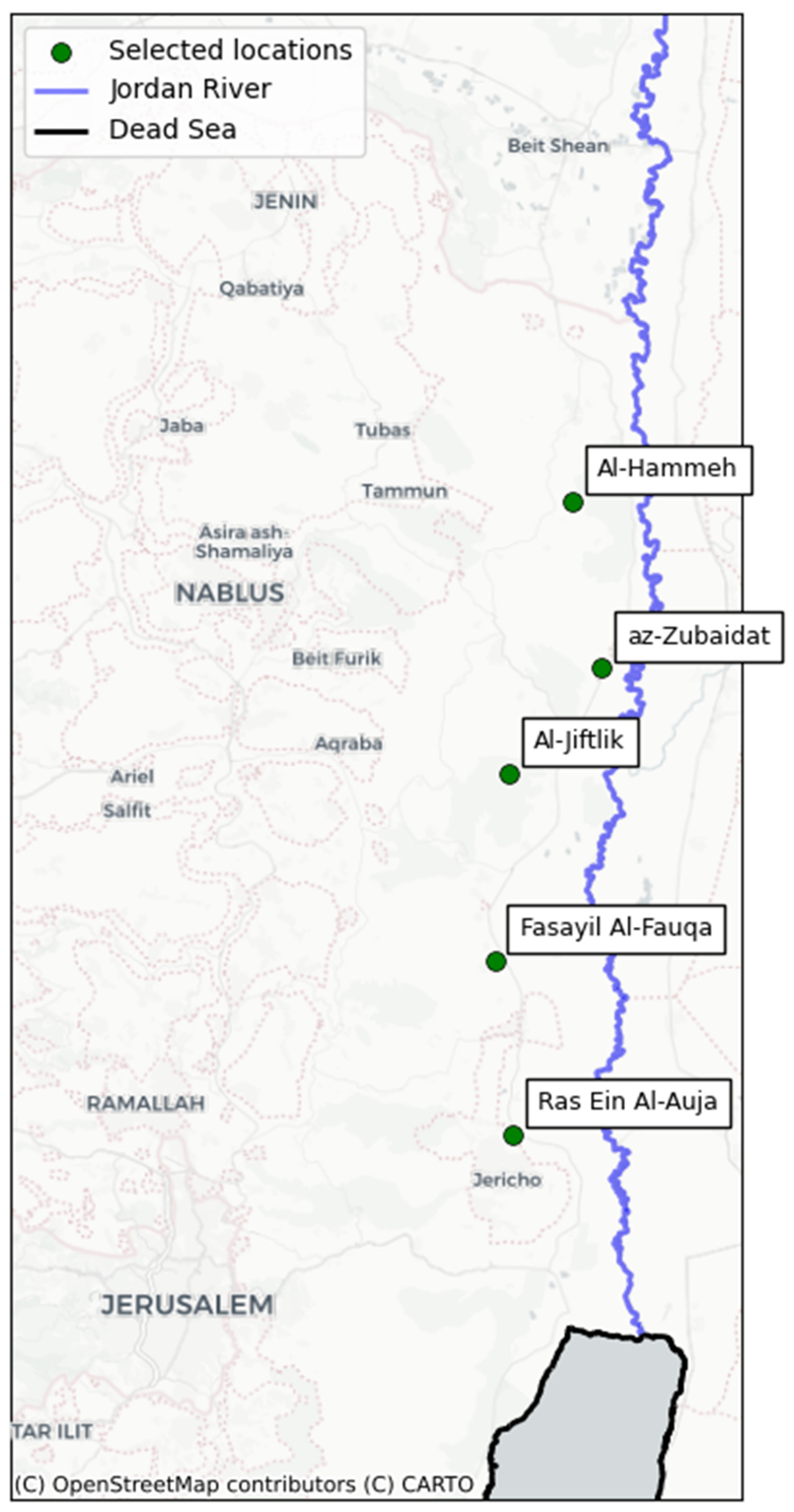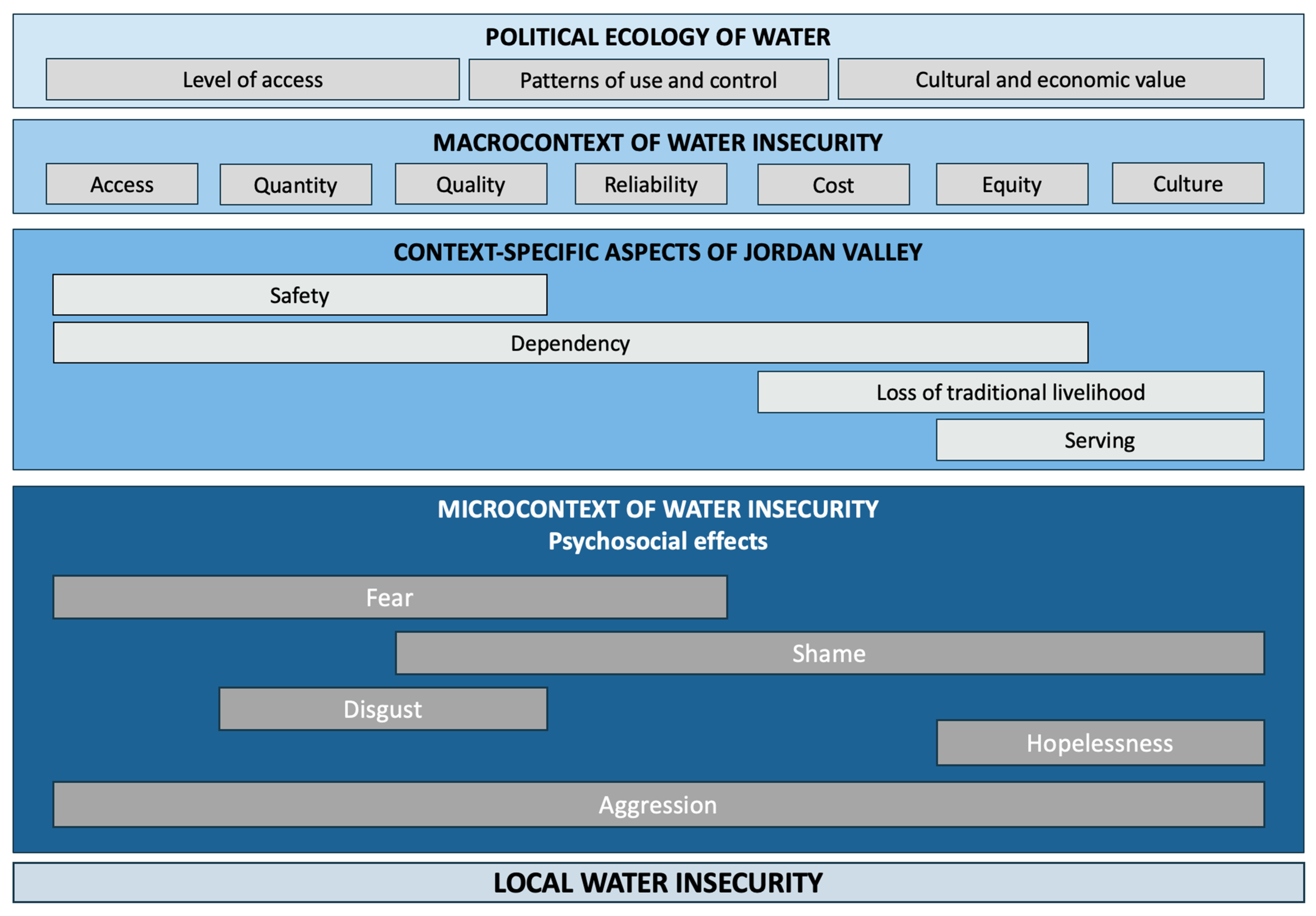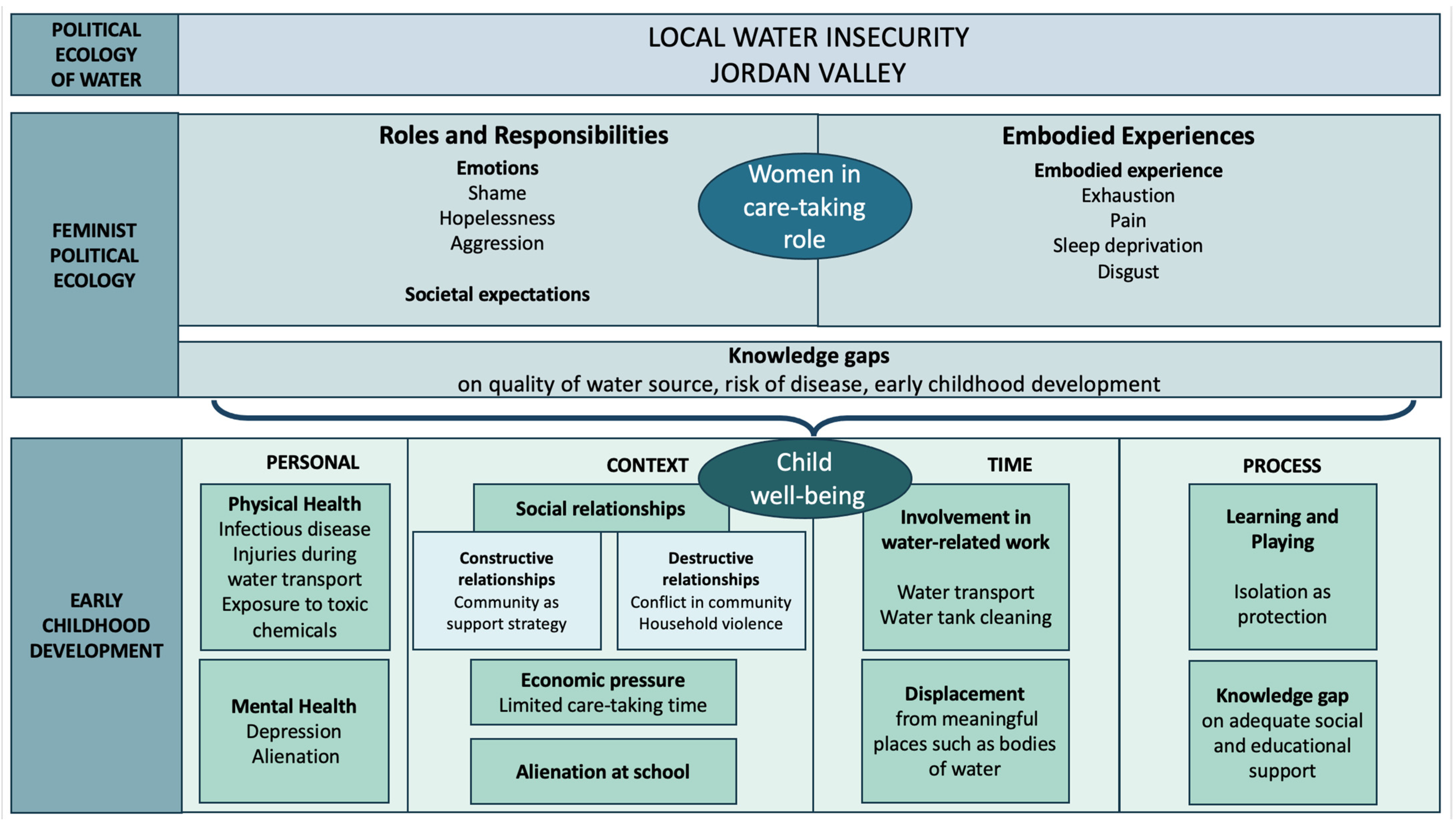Water Insecurity in the Jordan Valley: Community Perspectives on Its Impacts on Maternal and Child Health †
Abstract
:1. Introduction

2. Materials and Methods
2.1. Conceptual Framework
2.2. Study Sites and Participants
2.3. Data Collection
2.4. Data Analysis
3. Results
3.1. Context Specific Specific Aspects of Water Insecurity in the Jordan Valley
3.2. Psychosocial Implications for Women
3.2.1. Roles and Responsibilities
3.2.2. Embodied Experiences
3.3. Implications for Child Health
3.3.1. Context
3.3.2. Personal
3.3.3. Time
3.3.4. Process
4. Discussion
5. Strengths and Limitations
6. Conclusions
Supplementary Materials
Author Contributions
Funding
Institutional Review Board Statement
Informed Consent Statement
Data Availability Statement
Acknowledgments
Conflicts of Interest
Appendix A. Characteristics of FGD Participants and Location
| Participants | Place of the FGD | Water Sources in the Community | |
| Pilot | 5 women | Participant’s home | Piped water network, tanks |
| FGD1 | 11 women | Participant’s home | Tanks, spring |
| FGD2 | 3 women | Participant’s home | Tanks, well, rainwater |
| FGD3 | 6 women | Participant’s home | Tanks |
| FGD4 | 3 women | Council hall | Water network, tanks, protected well, spring |
References
- UNHRC. The Human Right to Safe Drinking Water and Sanitation: United Nations Human Rights Council. 2011. Available online: https://www.worldwatercouncil.org/fileadmin/wwc/Right_to_Water/Human_Rights_Council_Resolution_cotobre_2011.pdf (accessed on 28 August 2023).
- UNCCS. Opportunities and Options for Integrating Climate Change Adaptation with the Sustainable Development Goals and the Sendai Framework for Disaster Risk Reduction 2015–2030: United Nations Climate Change Secretariat. 2017. Available online: https://unfccc.int/sites/default/files/resource/techpaper_adaptation.pdf (accessed on 28 August 2023).
- PNIPH; WHO. Water Scarcity and Health Concerns in Palestine: WHO, The Palestinian National Institute of Public Health. 2015. Available online: https://www.pniph.org/images/research/pniph-who-water_report_final.pdf (accessed on 28 August 2023).
- Sarsour, A.; Nagabhatla, N. Options and Strategies for Planning Water and Climate Security in the Occupied Palestinian Territories. Water 2022, 14, 3418. [Google Scholar] [CrossRef]
- Paz, S.; Majeed, A.; Christophides, G.K. Climate change impacts on infectious diseases in the Eastern Mediterranean and the Middle East (EMME)-risks and recommendations. Clim. Change 2021, 169, 40. [Google Scholar] [CrossRef] [PubMed]
- Hajat, S.; Proestos, Y.; Araya-Lopez, J.-L.; Economou, T.; Lelieveld, J. Current and future trends in heat-related mortality in the MENA region: A health impact assessment with bias-adjusted statistically downscaled CMIP6 (SSP-based) data and Bayesian inference. Lancet Planet Health 2023, 7, e282–e290. [Google Scholar] [CrossRef] [PubMed]
- Dai, L. Implementation Constraints on Israel–Palestine Water Cooperation: An Analysis Using the Water Governance Assessment Framework. Water 2021, 13, 620. [Google Scholar] [CrossRef]
- Neira, M.; Erguler, K.; Ahmady-Birgani, H.; Al-Hmoud, N.D.; Fears, R.; Gogos, C.; Hobbhahn, N.; Koliou, M.; Kostrikis, L.G.; Lelieveld, J.; et al. Climate change and human health in the Eastern Mediterranean and Middle East: Literature review, research priorities and policy suggestions. Environ. Res. 2023, 216, 114537. [Google Scholar] [CrossRef]
- Hajat, S.; Gampe, D.; Sarsour, A.; Abuzerr, S. Climate Change and Diarrhoeal Disease Burdens in the Gaza Strip, Palestine: Health Impacts of 1.5 °C and 2 °C Global Warming Scenarios. Int. J. Environ. Res. Public Health 2022, 19, 4898. [Google Scholar] [CrossRef]
- WorldBank. Securing Water for Development in West Bank and Gaza; World Bank: Washington, DC, USA, 2018. [Google Scholar]
- OpenStreetMap Contributors. OpenStreetMap Database [PostgreSQL via API]. OpenStreetMap Foundation: Cambridge, UK, 10 January 2021. [Google Scholar]
- UNHRC. The Allocation of Water Resources in the Occupied Palestinian Territory, Including East Jerusalem United Nations Human Rights Council. 2021. Available online: https://www.un.org/unispal/wp-content/uploads/2021/10/A.HRC_.48.43_230921.pdf (accessed on 28 August 2023).
- PNIPH. Prevalence and Determinants of Malnutrition and Intestinal Infections among Children and their Mothers in the Jordan Valley. Palestinian National Institute of Public Health: Ramallah, Palestine, 2016. [Google Scholar]
- Water Usage in Area C; United Nations Development Programme: Jerusalem, Israel, 2013; Available online: https://www.undp.org/sites/g/files/zskgke326/files/migration/ps/UNDP-papp-reserach-bedouinsoPt.pdf (accessed on 28 August 2023).
- Mihlar, F. Israel’s Denial of the Bedouin; Minority Rights Group International: London, UK, 2011. [Google Scholar]
- UNDP. INFOCUS Bedouins in the Occupied Palestinian Territory; United Nations Development Programme: Jerusalem, Israel, 2013.
- Waddington, S.; Masset, E.; Bick, S.; Cairncross, S. Impact on childhood mortality of interventions to improve drinking water, sanitation, and hygiene (WASH) to households: Systematic review and meta-analysis. PLoS Med. 2023, 20, e1004215. [Google Scholar] [CrossRef] [PubMed]
- Ross, I.; Bick, S.; Ayieko, P.; Dreibelbis, R.; Wolf, J.; Freeman, M.C.; Allen, E.; Brauer, M.; Cumming, O. Effectiveness of handwashing with soap for preventing acute respiratory infections in low-income and middle-income countries: A systematic review and meta-analysis. Lancet 2023, 401, 1681–1690. [Google Scholar] [CrossRef] [PubMed]
- MoH. Health Annual Report, Palestine 2020; Ministry of Health: Ramallah, Israel, 2021.
- Hamarsheh, O.; Amro, A. Epidemiology of Parasitic Infections in the West Bank and Gaza Strip, Palestine. Am. J. Trop. Med. Hyg. 2020, 102, 313–317. [Google Scholar] [CrossRef] [PubMed]
- UNICEF; WHO. Progress on Household Drinking Water, Sanitation and Hygiene 2000–2022: Special Focus on Gender; United Nations Children’s Fund (UNICEF) and World Health Organization (WHO): New York, NY, USA, 2023.
- Wutich, A. Intrahousehold disparities in women and men’s experiences of water insecurity and emotional distress in urban Bolivia. Med. Anthropol. Q. 2009, 23, 436–454. [Google Scholar] [CrossRef] [PubMed]
- Shakhshir, G. Water Stress and Early Childhood Development in Palestine: Making the Link, and Implications for Policy and Practice. Ph.D Thesis, London School of Hygiene & Tropical Medicine, London, UK, 2021. [Google Scholar]
- Jalali, R. The role of Water, Sanitation, Hygiene, and Gender Norms on Women’s Health: A conceptual Framework. Gendered Perspect. Int. Dev. 2021, 1, 21–44. [Google Scholar] [CrossRef]
- WRA. What Women Want: Demands for Quality Healthcare; White Ribbon Alliance: Washington, DC, USA, 2022. [Google Scholar]
- Nasreen, S.; Amin, N. Effects of handwashing with soap on acute respiratory infections in low-resource settings: Challenges and ways forward. Lancet 2023, 401, 1634–1635. [Google Scholar] [CrossRef] [PubMed]
- Dreibelbis, R.; Winch, P.J.; Leontsini, E.; Hulland, K.R.S.; Ram, P.K.; Unicomb, L.; Luby, S.P. The Integrated Behavioural Model for Water, Sanitation, and Hygiene: A systematic review of behavioural models and a framework for designing and evaluating behaviour change interventions in infrastructure-restricted settings. BMC Public Health 2013, 13, 1015. [Google Scholar] [CrossRef] [PubMed]
- Bowles, D.C.; Butler, C.D.; Morisetti, N. Climate change, conflict and health. J. R. Soc. Med. 2015, 108, 390–395. [Google Scholar] [CrossRef] [PubMed]
- Smiley, S.L.; Stoler, J. Socio-environmental confounders of safe water interventions. WIREs Water 2020, 7, e1438. [Google Scholar] [CrossRef]
- Panday, S.; Rushton, S.; Karki, J.; Balen, J.; Barnes, A. The role of social capital in disaster resilience in remote communities after the 2015 Nepal earthquake. Int. J. Disaster Risk Reduct. 2021, 55, 102112. [Google Scholar] [CrossRef]
- Legge, H.; Shaheen, A.; Shakhshir, G.; Milojevic, A. Access to water and morbidity in children in the occupied Palestinian territory, 2000–2014: A repeated cross-sectional study. Lancet 2018, 391 (Suppl 2), S8. [Google Scholar] [CrossRef] [PubMed]
- Fahoum, K.; Abuelaish, I. Occupation, settlement, and the social determinants of health for West Bank Palestinians. Med. Confl. Surviv. 2019, 35, 265–283. [Google Scholar] [CrossRef]
- Khatib, G.; Hamada, M.; Sarsour, A.K. Common Waterborne Diseases in Marginalized areas: A Case Study: Al Shuka Area in Gaza Strip—Palestine. IJSR 2016, 5, e2319–e7064. [Google Scholar]
- Abu Mourad, T.A. Palestinian refugee conditions associated with intestinal parasites and diarrhoea: Nuseirat refugee camp as a case study. Public Health 2004, 118, 131–142. [Google Scholar] [CrossRef]
- Young, S. National Water Insecurity in Palestine. Available online: https://csis-ilab.github.io/js-viz/wise-infographic (accessed on 14 January 2025).
- Damkjaer, S.; Taylor, R. The measurement of water scarcity: Defining a meaningful indicator. Ambio 2017, 46, 513–531. [Google Scholar] [CrossRef] [PubMed]
- Stevenson, E.G.; Greene, L.E.; Maes, K.C.; Ambelu, A.; Tesfaye, Y.A.; Rheingans, R.; Hadley, C. Water insecurity in 3 dimensions: An anthropological perspective on water and women’s psychosocial distress in Ethiopia. Soc. Sci. Med. 2012, 75, 392–400. [Google Scholar] [CrossRef] [PubMed]
- Subbaraman, R.; Nolan, L.; Sawant, K.; Shitole, S.; Shitole, T.; Nanarkar, M.; Patil-Deshmukh, A.; Bloom, D.E. Multidimensional Measurement of Household Water Poverty in a Mumbai Slum: Looking Beyond Water Quality. PLoS ONE 2015, 10, e0133241. [Google Scholar] [CrossRef] [PubMed]
- Young, S.L.; Bethancourt, H.J.; Ritter, Z.R.; Frongillo, E.A. Estimating national, demographic, and socioeconomic disparities in water insecurity experiences in low-income and middle-income countries in 2020–21: A cross-sectional, observational study using nationally representative survey data. Lancet Planet Health 2022, 6, e880–e891. [Google Scholar] [CrossRef] [PubMed]
- Jepson, W.; Wutich, A.; Collins, S.; Boateng, G.; Young, S. Progress in household water insecurity metrics: A cross-disciplinary approach. WIREs Water 2017, 4, e1214. [Google Scholar] [CrossRef]
- Hawe, P.; Shiell, A.; Riley, T. Theorising interventions as events in systems. Am. J. Community Psychol. 2009, 43, 267–276. [Google Scholar] [CrossRef] [PubMed]
- Scheelbeek, P.F.D.; Hamza, Y.A.; Schellenberg, J.; Hill, Z. Improving the use of focus group discussions in low income settings. BMC Med. Res. Methodol. 2020, 20, 287. [Google Scholar] [CrossRef]
- Tong, A.; Sainsbury, P.; Craig, J. Consolidated criteria for reporting qualitative research (COREQ): A 32-item checklist for interviews and focus groups. IJQHC 2007, 19, 349–357. [Google Scholar] [CrossRef]
- Johnston, B.R. The Political Ecology of Water: An Introduction. Cap. Nat. Soc. 2003, 14, 73–90. [Google Scholar]
- Elmhirst, R. Feminist political ecology. In Handbook of Political Ecology; Perreault, T., Bridge, G., McCarthy, J., Eds.; Routledge: Oxon, UK, 2015; pp. 519–530. [Google Scholar]
- Truelove, Y. (Re-)Conceptualizing water inequality in Delhi, India through a feminist political ecology framework. Geoforum 2011, 42, 143–152. [Google Scholar] [CrossRef]
- Bronfenbrenner, U.; Morris, P.A. The bioecological model of human development. In Handbook of Child Psychology; Wiley: Hoboken, NJ, USA, 2007. [Google Scholar]
- Tudge, J.; Rosa, E.M. Bronfenbrenner’s Ecological Theory. In The Encyclopedia of Child and Adolescent Development; Hupp, S., Jewell, J., Eds.; Wiley: Hoboken, NJ, USA, 2023; pp. 1–11. [Google Scholar]
- Nyumba, T.O.; Wilson, K.; Derrick, C.J.; Mukherjee, N. The use of focus group discussion methodology: Insights from two decades of application in conservation. Methods Ecol. Evol. 2018, 9, 20–32. [Google Scholar] [CrossRef]
- Braun, V.; Clarke, V. Using thematic analysis in psychology. Qual. Res. Psychol. 2006, 3, 77–101. [Google Scholar] [CrossRef]
- Gioia, D.A.; Corley, K.G.; Hamilton, A.L. Seeking Qualitative Rigor in Inductive Research: Notes on the Gioia Methodology. Organ. Res. Methods 2013, 16, 15–31. [Google Scholar] [CrossRef]
- Tallman, P.S.; Collins, S.; Salmon-Mulanovich, G.; Rusyidi, B.; Kothadia, A.; Cole, S. Water insecurity and gender-based violence: A global review of the evidence. WIREs Water 2023, 10, e1619. [Google Scholar] [CrossRef]
- Wutich, A.; Ragsdale, K. Water insecurity and emotional distress: Coping with supply, access, and seasonal variability of water in a Bolivian squatter settlement. Soc. Sci. Med. 2008, 67, 2116–2125. [Google Scholar] [CrossRef]
- Cooper-Vince, C.E.; Arachy, H.; Kakuhikire, B.; Vořechovská, D.; Mushavi, R.C.; Baguma, C.; McDonough, A.Q.; Bangsberg, D.R.; Tsai, A.C. Water insecurity and gendered risk for depression in rural Uganda: A hotspot analysis. BMC Public Health 2018, 18, 1143. [Google Scholar] [CrossRef] [PubMed]
- Tsai, A.C.; Kakuhikire, B.; Mushavi, R.; Vořechovská, D.; Perkins, J.M.; McDonough, A.Q.; Bangsberg, D.R. Population-based study of intra-household gender differences in water insecurity: Reliability and validity of a survey instrument for use in rural Uganda. J. Water Health 2016, 14, 280–292. [Google Scholar] [CrossRef]
- Sultana, F. Fluid lives: Subjectivities, gender and water in rural Bangladesh. Gend. Place Cult. 2009, 16, 427–444. [Google Scholar] [CrossRef]
- Collins, S.M.; Mbullo Owuor, P.; Miller, J.D.; Boateng, G.O.; Wekesa, P.; Onono, M.; Young, S.L. ‘I know how stressful it is to lack water!’ Exploring the lived experiences of household water insecurity among pregnant and postpartum women in western Kenya. Glob. Public Health 2019, 14, 649–662. [Google Scholar] [CrossRef]
- Bisung, E.; Elliott, S.J. Psychosocial impacts of the lack of access to water and sanitation in low- and middle-income countries: A scoping review. J. Water Health 2016, 15, 17–30. [Google Scholar] [CrossRef]
- Sultana, F. Suffering for water, suffering from water: Emotional geographies of resource access, control and conflict. Geoforum 2011, 42, 163–172. [Google Scholar] [CrossRef]
- Venkataramanan, V.; Geere, J.L.; Thomae, B.; Stoler, J.; Hunter, P.R.; Young, S.L. In pursuit of ’safe’ water: The burden of personal injury from water fetching in 21 low-income and middle-income countries. BMJ Glob. Health 2020, 5, e003328. [Google Scholar] [CrossRef] [PubMed]
- Bisung, E.; Elliott, S.J. ‘Everyone is exhausted and frustrated’: Exploring psychosocial impacts of the lack of access to safe water and adequate sanitation in Usoma, Kenya. WaSHDev 2016, 6, 205–214. [Google Scholar] [CrossRef]
- Sullivan, C.A.; Meigh, J.R.; Giacomello, A.M. The Water Poverty Index: Development and application at the community scale. Nat. Resour. Forum 2003, 27, 189–199. [Google Scholar] [CrossRef]
- MacArthur, J.; Carrard, N.; Willetts, J. WASH and Gender: A critical review of the literature and implications for gender-transformative WASH research. WaSHDev 2020, 10, 818–827. [Google Scholar] [CrossRef]
- Dery, F.; Bisung, E.; Dickin, S.; Dyer, M. Understanding empowerment in water, sanitation, and hygiene (WASH): A scoping review. WaSHDev 2019, 10, 5–15. [Google Scholar] [CrossRef]
- Leahy, C.; Winterford, K.; Nghiem, T.; Kelleher, J.; Leong, L.; Willetts, J. Transforming gender relations through water, sanitation, and hygiene programming and monitoring in Vietnam. Gend. Dev. 2017, 25, 283–301. [Google Scholar] [CrossRef]
- Ali, M.; Stevens, L. Integrated approaches to promoting sanitation: A case study of Faridpur, Bangladesh. Desalination 2009, 248, 1–7. [Google Scholar] [CrossRef]
- Leder, S.; Clement, F.; Karki, E. Reframing women’s empowerment in water security programmes in Western Nepal. Gend. Dev. 2017, 25, 235–251. [Google Scholar] [CrossRef]
- Rhue, S.J.; Torrico, G.; Amuzie, C.; Collins, S.M.; Lemaitre, A.; Workman, C.L.; Rosinger, A.Y.; Pearson, A.L.; Piperata, B.A.; Wutich, A.; et al. The effects of household water insecurity on child health and well-being. WIREs Water 2023, 10, e1666. [Google Scholar] [CrossRef]
- Bryce, J.W.; Walker, N.; Ghorayeb, F.; Kanj, M. Life experiences, response styles and mental health among mothers and children in Beirut, Lebanon. Soc. Sci. Med. 1989, 28, 685–695. [Google Scholar] [CrossRef] [PubMed]
- Eisenberg, L.; Belfer, M. Prerequisites for global child and adolescent mental health. J. Child. Psychol. Psychiatry 2009, 50, 26–35. [Google Scholar] [CrossRef] [PubMed]
- Asaba, R.B.; Fagan, H.; Kabonesa, C.; Mugumya, F. Beyond distance and time: Gender and the burden of water collection in rural Uganda. wH2O J. Gend. Water 2013, 2, 31–38. [Google Scholar]
- Hutton, G.; Chase, C. Water Supply, Sanitation, and Hygiene. In Injury Prevention and Environmental Health, 3rd ed.; Mock, C.N., Nugent, R., Kobusingye, O., Smith, K.R., Eds.; The International Bank for Reconstruction and Development/The World Bank: Washington, DC, USA, 2017. [Google Scholar]
- Majeed, H.; Lee, J. The impact of climate change on youth depression and mental health. Lancet Planet Health 2017, 1, e94–e95. [Google Scholar] [CrossRef] [PubMed]
- Eichelberger, L. Household water insecurity and its cultural dimensions: Preliminary results from Newtok, Alaska. Environ Sci. Pollut. Res. 2018, 25, 32938–32951. [Google Scholar] [CrossRef] [PubMed]
- Bartlett, S. Water, sanitation and urban children: The need to go beyond “improved” provision. Environ. Urban 2003, 15, 57–70. [Google Scholar]
- Braun, V.; Clarke, V. (Mis)conceptualising themes, thematic analysis, and other problems with Fugard and Potts’ (2015) sample-size tool for thematic analysis. Int. J. Soc. Res. Methodol. 2016, 19, 739–743. [Google Scholar] [CrossRef]


Disclaimer/Publisher’s Note: The statements, opinions and data contained in all publications are solely those of the individual author(s) and contributor(s) and not of MDPI and/or the editor(s). MDPI and/or the editor(s) disclaim responsibility for any injury to people or property resulting from any ideas, methods, instructions or products referred to in the content. |
© 2025 by the authors. Licensee MDPI, Basel, Switzerland. This article is an open access article distributed under the terms and conditions of the Creative Commons Attribution (CC BY) license (https://creativecommons.org/licenses/by/4.0/).
Share and Cite
Walther, A.; Shaheen, A.; Zubeidat, H.; Shakhshir, G.; Hajat, S. Water Insecurity in the Jordan Valley: Community Perspectives on Its Impacts on Maternal and Child Health. Int. J. Environ. Res. Public Health 2025, 22, 187. https://doi.org/10.3390/ijerph22020187
Walther A, Shaheen A, Zubeidat H, Shakhshir G, Hajat S. Water Insecurity in the Jordan Valley: Community Perspectives on Its Impacts on Maternal and Child Health. International Journal of Environmental Research and Public Health. 2025; 22(2):187. https://doi.org/10.3390/ijerph22020187
Chicago/Turabian StyleWalther, Antonia, Amira Shaheen, Hamza Zubeidat, Ghassan Shakhshir, and Shakoor Hajat. 2025. "Water Insecurity in the Jordan Valley: Community Perspectives on Its Impacts on Maternal and Child Health" International Journal of Environmental Research and Public Health 22, no. 2: 187. https://doi.org/10.3390/ijerph22020187
APA StyleWalther, A., Shaheen, A., Zubeidat, H., Shakhshir, G., & Hajat, S. (2025). Water Insecurity in the Jordan Valley: Community Perspectives on Its Impacts on Maternal and Child Health. International Journal of Environmental Research and Public Health, 22(2), 187. https://doi.org/10.3390/ijerph22020187





